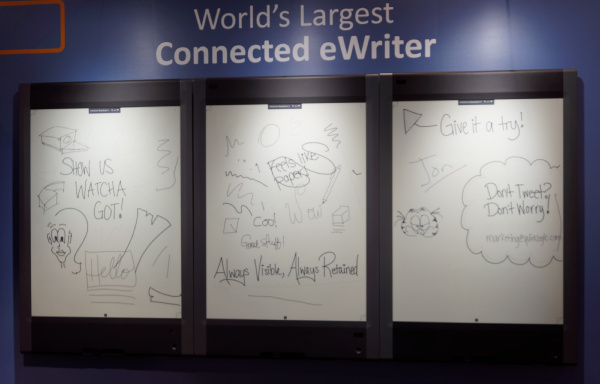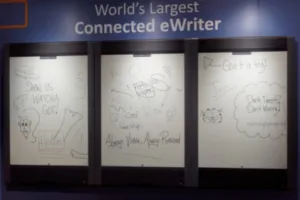Quirk Logic was a new name to us – it’s a new company that has been established to develop a new class of product – an electronic equivalent of a flip chart based on E Ink technology – and which it calls an eWriter. It’s not quite finalised, so Infocomm represented a ‘soft launch’ opportunity to get feedback from users and analysts. We were the first journalists to see it!

The chart is based on a 42″ E Ink display, the largest we have seen to date. The product is a complete system including processing and touch and the unit also includes a battery, so can be used for 15-20 hours without mains connectivity, which is intended to allow the board to be taken away for ‘break out’ meetings.
The unit includes PCap touch technology and can be used with a ‘live pen’ but which does not use a battery. The power for the pen is supplied using wireless technology, but it can also support finger touch. It uses NFC and QR codes for communications with the user.
The system includes data exchange to the cloud and images are created on a virtual canvas that can be extended beyond the physical limits of the display. The format for the workbooks is proprietary and the system identifies workbooks with individuals, so the idea is that you can walk up to the board, log in using NFC or QR codes and then see your notebooks. PDFs and images can be imported.
Multiple displays can be tiled to allow access to larger areas. The firm told us that it is working on reducing the width of the side borders of the display.
The product is due to ship at the end of 2016 and the main launch will be at CES. Pricing will be decided nearer to launch.
Analyst Comment
This is an interesting product that aims at the same kind of space as the Smart Kapp boards, but, unlike the Kapp, it can show previous content and allow it to be edited on the display. The biggest downside that I saw on the system is that response time is a bit slow, and there is a slightly disconcerting lag between the touch and the display. An artist using the system said that you quickly get used to the delay, but it might be off-putting to new users. The company hopes to improve this before launch. (BR)

